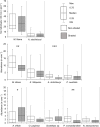Detecting Subtle Shifts in Ecosystem Functioning in a Dynamic Estuarine Environment
- PMID: 26214854
- PMCID: PMC4516327
- DOI: 10.1371/journal.pone.0133914
Detecting Subtle Shifts in Ecosystem Functioning in a Dynamic Estuarine Environment
Abstract
Identifying the effects of stressors before they impact ecosystem functioning can be challenging in dynamic, heterogeneous 'real-world' ecosystems. In aquatic systems, for example, reductions in water clarity can limit the light available for photosynthesis, with knock-on consequences for secondary consumers, though in naturally turbid wave-swept estuaries, detecting the effects of elevated turbidity can be difficult. The objective of this study was to investigate the effects of shading on ecosystem functions mediated by sandflat primary producers (microphytobenthos) and deep-dwelling surface-feeding macrofauna (Macomona liliana; Bivalvia, Veneroida, Tellinidae). Shade cloths (which reduced incident light intensity by ~80%) were deployed on an exposed, intertidal sandflat to experimentally stress the microphytobenthic community associated with the sediment surface. After 13 weeks, sediment properties, macrofauna and fluxes of oxygen and inorganic nutrients across the sediment-water interface were measured. A multivariate metric of ecosystem function (MF) was generated by combining flux-based response variables, and distance-based linear models were used to determine shifts in the drivers of ecosystem function between non-shaded and shaded plots. No significant differences in MF or in the constituent ecosystem function variables were detected between the shaded and non-shaded plots. However, shading reduced the total explained variation in MF (from 64% in non-shaded plots to 15% in shaded plots) and affected the relative influence of M. liliana and other explanatory variables on MF. This suggests that although shade stress may shift the drivers of ecosystem functioning (consistent with earlier investigations of shading effects on sandflat interaction networks), ecosystem functions appear to have a degree of resilience to those changes.
Conflict of interest statement
Figures




Similar articles
-
Altered nitrogen transformation pathways and a legacy of sediment organic matter enrichment.Mar Pollut Bull. 2022 Sep;182:114014. doi: 10.1016/j.marpolbul.2022.114014. Epub 2022 Aug 5. Mar Pollut Bull. 2022. PMID: 35939937
-
Experimenting with ecosystem interaction networks in search of threshold potentials in real-world marine ecosystems.Ecology. 2014 Jun;95(6):1451-7. doi: 10.1890/13-1879.1. Ecology. 2014. PMID: 25039209
-
Disturbance of sandflats by thin terrigenous sediment deposits: consequences for primary production and nutrient cycling.Ecol Appl. 2011 Mar;21(2):416-26. doi: 10.1890/09-1845.1. Ecol Appl. 2011. PMID: 21563573
-
Ecological and toxicological effects of inorganic nitrogen pollution in aquatic ecosystems: A global assessment.Environ Int. 2006 Aug;32(6):831-49. doi: 10.1016/j.envint.2006.05.002. Epub 2006 Jun 16. Environ Int. 2006. PMID: 16781774 Review.
-
Consumer-driven nutrient dynamics in freshwater ecosystems: from individuals to ecosystems.Biol Rev Camb Philos Soc. 2017 Nov;92(4):2003-2023. doi: 10.1111/brv.12318. Epub 2016 Dec 23. Biol Rev Camb Philos Soc. 2017. PMID: 28008706 Review.
Cited by
-
NZTD - The New Zealand Trait Database for shallow-water marine benthic invertebrates.Sci Data. 2023 Jul 29;10(1):502. doi: 10.1038/s41597-023-02414-6. Sci Data. 2023. PMID: 37516737 Free PMC article.
-
Same pattern, different mechanism: Locking onto the role of key species in seafloor ecosystem process.Sci Rep. 2016 May 27;6:26678. doi: 10.1038/srep26678. Sci Rep. 2016. PMID: 27230562 Free PMC article.
References
-
- Dayton PK, Tegner MJ. Catastrophic Storms, El Niño, and Patch Stability in a Southern California Kelp Community. Science. 1984; 224: 283–285. - PubMed
-
- Foster DR., Knight DH, Franklin JF. Landscape patterns and legacies resulting from large, infrequent forest disturbances. Ecosystems. 1998; 1: 497–510.
-
- Dayton PK, Tegner MJ, Edwards PB, Riser KL. Sliding baselines, ghosts and reduced expectations in kelp forest communities. Ecol Appl. 1998; 8: 309–322.
Publication types
MeSH terms
LinkOut - more resources
Full Text Sources
Other Literature Sources

